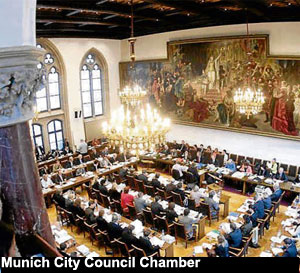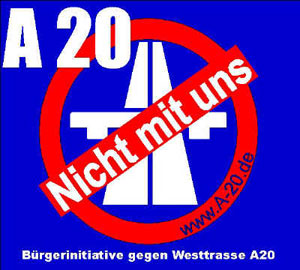
Helmut Himmels, the independent mayor of Heilbronn, Baden-Württemberg. More than half of all mayors of the southern German state of Baden-Wuerttemberg were elected as independents. Across the whole of Germany, 103 mayor of big cities are Social Democrats (centre-left), 87 Christian Democrats (conservative), 47 independent, 28 Christian Socialists (Bavarian conservatives) and six belong to the Green Party

FRONT PAGE
Site Search
About us



German mayors and their salaries
German local government
German government
German local elections 2014
Stuttgart Region works
Mayors in Europe
Government index
Germany's largest cities

Worldwide | Elections | North America | Latin America | Europe | Asia | Africa |

























The participation of citizens
in German local government
By Jens Tessmann, Potsdam University and
Irmelind Kirchner, Japan Local Government Centre London
21 September 2011: For historical and constitutional reasons, the organisation of the local community in Germany is first and foremost the domain of local people. Through political and civic engagement of citizens in their community, municipalities embody the living, breathing foundation of the state. The local polity has at its core a system of representative democracy, which traditionally forms the main area of political participation. This is made visible in the distinction between ‘resident’ and ‘citizen’: a resident only becomes a citizen through the right to vote in elections for the council and to stand for election. This bestows full participation rights but also duties.
1) Historical background
2) Directly elected mayors
3) Citizens initiatives
4) Direct democracy
5) Co-operative democracy
6) Commissioning role
7) Co-producer role
8) The citizen-centred municipality
The elected citizens as member of the council represent the interests of the community citizens (the voters) independently and without taking instructions are able to influence the directions, aims and use of resources of community policy by participating in the central interest-aggregation and decision-making process. The council has competence in areas, which are defined as local self-governing affairs but no say in those tasks, which the state has transferred for execution to the local level. In concrete terms, the council can decide on senior personnel decisions, the boundaries of the community unit, the local bylaws, budget and personnel plans, business plans, land use planning and town planning issues, as well as decision-making in local social, youth, senior citizens, cultural, sports and green space policies; equally infrastructure, energy and economic policy as far as it is a localised issue.
 Historical background
Historical background
For a long time, the ideal of community politics was that it should be entirely driven by facts and circumstances and not be party-political, with people of high standing in the community – local dignitaries such as landlords and successful business people as well as representatives of the professions – comprising the council. Those citizens, not elected to the council, could only influence local politics through individual councillors but had no other official channel of participation.
Following developments to democratise the German state during the Weimar Republic (1919 – 1933), party politics gained influence also at local level. Social issues of the day, but also the need for broader emancipation through political participation were important factors. By engaging within political parties, citizens not elected to the council could through party-based discussions and decisions influence the decision-making within the council through ‘their’ councillors. As a result, they gained independence from the goodwill and personal interest of local dignitaries.
Democratisation of local politics however remained constrained and came to a complete halt after the National Socialists (Nazis) came to power and erected a totalitarian unitary state. Immediately after the Second World War, different options for citizen participation were not included in local government legislation. In the reconstruction phase, local politics was very much apolitical and dominated by technical-executive decision-making. Only from the 1970s onward did party politics and parliamentarianism make inroads into local government. Change of values and engagement with social and environmental issues led to increased interest by citizens in active participation.
Introduction of directly elected mayors
Apart from Bavaria and Baden-Württemberg, which always had directly elected mayors, until 1990 mayors were elected by the council. In the wake of re-unification, after 1990, and the new enthusiasm for grassroots democracy, direct elections of mayors were introduced in all large federal states (Länder) and with some exceptions for the heads of counties (Kreise) as well. This gave the citizens the opportunity to exert a direct influence on the leadership of the local authority. Apart from strengthening democratic participation by the citizens, the aim was to emphasise the common good over special interests. The other aim was increased efficiency through streamlining the leadership.
Research has shown that the power and influence of mayors and with them the administrative experts has increased, while that of the elected councillors, who are serving in an honorary capacity and not in a full-time capacity, has decreased. The influence of citizens was also strengthened. However, there are differences between the Länder owing to their different traditions in how much the role of the mayor has been strengthened. For example, in North Rhine-Westphalia, the party-political orientation and as such the influence of the senior leadership of the dominant party in the council is much stronger than is the case in Baden-Württemberg.
 Citizens initiatives
Citizens initiatives
In the 1970, citizens grouped together for the pursuit of common interests in so-called citizens initiatives (Bürgerinitiativen). Through this kind of self-organisation, citizens were able to have discussions and voice opinions outside of council and party discussions, and use the media to reach a wider public. Stronger political engagement within and outside of the council chamber led to increasing influence of social and environmental aspects within the sphere of influence of the local authority, broadening economically and technically focused local policy. Despite these indirect political successes, citizen initiatives were not codified in legal form as an instrument of direct participation. In general, citizen initiatives tended to take an adversarial position towards the council and saw themselves as an opposition force. They can be regarded as an important precursor to the forms of direct democracy as developed today.
Developments in direct democracy
In some of the remaining very small-scale local authorities (for example in Schleswig-Holstein), instead of elections, meetings of all residents act as the decision-making body (while administrative functions are performed by a shared organisation to which a number of local authorities belong), but in larger local authorities in most Länder such direct participation did not exist. However, the system of ‘citizen assemblies’ or ‘residents’ assemblies’ (Bürgerversammlung/Einwohnerversammlung) has long existed. In some Länder this takes the form of a duty of the local authority to regularly hold meetings, while in others they can be held on the initiative of the council or on demand from the citizens. They can only deal with matters in the purview of local government and are mainly for information sharing purposes, as such assemblies cannot make decisions.
After re-unification, the enthusiasm for direct democracy that resulted in directly elected mayors led to the introduction of more direct-democratic instruments as well, following the example of Baden-Württemberg. Through local referenda citizens can in principle make decisions over important matters that are within the competence of the local authority. Functions which have been transferred from the state for execution, the administrative structure, budget matters as well as planning issues including the local land use plan are exempt, although this can vary between Länder. Local referenda can be either called through the elected council (in some Länder only), or by demand from the citizens (in all Länder). A minimum of signatures of 2.5% to 17% is needed to formally submit a demand for a local referendum. Topics can also include the demand to rescind a council decision. Such a demand for a referendum must include a clear referendum question (which can be answered with yes or no), an explanation to the background and reasoning, and an outline of cost recovery, should the proposal incur costs. A demand for a referendum for political reasons alone is not permitted; it has to deal with a tangible issue. If the council decides in favour of the demand made by the referendum question, there will be no referendum, otherwise it will go ahead.
In order to be valid, referenda must not only return a majority at turn-out, but achieve a majority of 10% to 30% of all voters, so setting quite high hurdles. The result of a referendum has the same legal force as a valid council decision and can only be changed within three years through a second referendum.
A further method of exerting more influence is the ‘citizen demand/residents demand’ (Bürgerantrag/ Einwohnerantrag), which was introduced mostly at the same time or slightly later than local referendums. The conditions differ between Länder: if they allow all residents, sometime also younger people below voting age, to participate, or restrict it to citizens. With such a demand, which has to be submitted in writing to the council and must be supported by signatures from one per cent to 30% of residents (or citizens) depending on the relevant legislation, the council can be forced to debate a certain issue. The formal decision on the validity of the demand can lie with the council, but in some Länder it is given to the mayor or the supervisory authority (the counties, or the Land interior ministry). Again it varies if the council is obliged to conduct a vote or just discuss the matter.
Research into the practice of local referenda regarding their frequency and rate of success has shown a limited impact on local government and varies considerably between Länder. However the existence of these instruments alone has made council and administration more likely to listen to and co-operate more closely with citizens, in order to increase acceptance of council decisions and administrative actions.
Co-operative democracy
Forms of co-operative democracy exist at the interface between representative and direct democracy. They have developed since the early 1980s in different forms, and although for the most part, they are not legally codified, scope for involving citizens in local government affairs can be deduced from the competence local authorities have in organising their own affairs under Article 28 of the Basic Law. Co-operative forms of democracy can be categorised as falling into two distinctive roles:
Commissioning role (Auftraggeberrolle)
In their commissioning role, citizens are participating in planning and decision processes together with elected politicians and the administration. In this area, thematic and time-limited approaches can be distinguished from permanent set-ups.
Time-limited methods such as citizen fora (Bürgerforum) and planning cells (Planungszelle) are employed to develop local solutions; mediation processes to overcome conflicts of interest are used as well. These approaches have a long history; already in the 1970s a variety of participatory approaches was introduced in the area of planning. Complex models of participation were developed although the outcome fell short of expectations. One reason was the limited support these attempts received from the officers, who wanted to limit the time and resources spent on such processes; and also the interest and ability of citizens to participate was overestimated. In the end, substantial dialogue took place only rarely, and in the majority of cases, the plans prepared by the administration remained mostly unchanged. However these experiences fed into the participation models used in planning processes to this day.
Permanent structures of co-operative democracy are the advisory councils (Beirat) formed of competent citizens. Examples are youth and senior citizen advisory councils, advisory councils on foreign residents, and the local advisory councils representing specific local areas within the municipality (Ortsteilbeirat). These advisory councils can have a legal basis and in the case of geographically defined advisory councils will often be elected. The function of these various advisory councils is the improvement of local development policies, transport policy and environmental policy, among others.
Co-producer role (Mitgestalterrolle)
As co-producers, citizens are encouraged to take over the running of community halls, pools, sports facilities and the like; and by engagement in self-help groups tackle problems related to drug use, unemployment and disability.
Individual engagement is also promoted in the form of time banks, volunteer centres and for example the care of public green spaces.
This area of citizen engagement is linked to the traditional volunteer activities that people in Germany undertake, where organisation in associations (Vereine) is wide-spread. Traditionally, associations were supported by grants from local authorities, while now such associations are increasingly encouraged to be financially self-sufficient without public funds.
Research conducted in North Rhine-Westphalia and Baden-Württemberg regarding the actual implementation of co-operative forms of democracy in 2003 found that the use of citizen fora as a means of gathering input and ideas from citizens is very popular. 85% of local authorities have used them for city marketing, 80% for issues connected to the Local Agenda 21, issues of youth policies 72%, and for crime prevention purposes 59%.
Forms of co-operative democracy are augmenting representative and direct democracy. Mayors and citizens have profited from this development, while on the other hand the scope of the elected council has narrowed.
However, in order to balance competing interests, guarantee social fairness and oversee the overall development of the community, the role of the council is vital, in particular regarding possible imbalances in political results emanating from forms of co-operative democracy. There is evidence that not all groups in society are equally represented when forms of co-operative democracy, for example citizen fora, are employed. Very often, it will be those with the loudest voices and the most educated and articulate who will be overrepresented, drowning out the socially marginalised and giving overdue influence to organised interests.
The citizen-centred municipality (Bürgerkommune)
From the end of the 1990s, the idea of the ‘citizen-centred municipality’ has been developing. Factors such as the demand for more citizen participation and learning from the failures of previous efforts, the difficulties in implementing the concept of the ‘new steering model’ management approach (which is the German version of New Public Management) and the financial crisis in many local authorities, have led to the demand for adopting a holistic approach, in which the development of a customer-focused administration goes hand in hand with a combined use of all different forms of representative, direct and co-operative democracy. The system of local self-government is to be improved in respect to democratic participation, solidarity, efficiency as well as effectiveness, increasing the acceptance of citizens of their community and the way it is governed. The citizens should be involved in their parallel roles as customers, commissioners and co-producers in all phases of decision-making and service delivery.
A ‘citizen participation manager’ is to be responsible for all aspects of participation, co-ordinating all stakeholders and working across traditional institutional boundaries. Also, responsibility is to be localised as much as possible to local areas to increase incentives for participation. Citizens should be able to see that their activities yield results.
To date, complete and successful realisation of this concept has not been achieved. Most local authorities implement specific elements of the concept, such as various forms of participatory budgeting, regular meetings dealing with local issues in small-scale areas, the establishment of volunteer centres or citizen foundations (Bürgerstiftungen) which are endowments with a specific public purpose, set up and run by citizens. Obstacles to achieving more citizen participation are first and foremost the financial difficulties of many local authorities, which hinder the investment needed to develop the mechanisms for participation further as well as activities by the local authority in general. Local authorities in the economically strong regions of southern Germany are further advanced on the way towards extensive citizen participation than those in the structurally weaker regions of central or eastern Germany. However, the concept of the citizen-centred municipality remains the ideal model of the modern local authority.
Follow @City_Mayors

